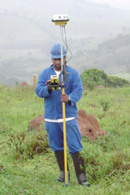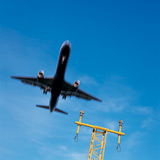New Civil Signals
A major focus of the GPS modernization program is the addition of new navigation signals to the satellite constellation.
The government is in the process of fielding three new signals designed for civilian use: L2C, L5, and L1C. The legacy civil signal, called L1 C/A or C/A at L1, will continue broadcasting, for a total of four civil GPS signals. Users must upgrade their equipment to benefit from the new signals.
The new civil signals are phasing in incrementally as the Air Force launches new GPS satellites to replace older ones. Most of the new signals will be of limited use until they are broadcast from 18 to 24 satellites.
Second Civil Signal: L2C
L2C is the second civilian GPS signal, designed specifically to meet commercial needs.
Its name refers to the radio frequency used by the signal (1227 MHz, or L2) and the fact that it is for civilian use. There are also two military signals at the L2 frequency.
When combined with L1 C/A in a dual-frequency receiver, L2C enables ionospheric correction, a technique that boosts accuracy. Civilians with dual-frequency GPS receivers enjoy the same accuracy as the military (or better).

For professional users with existing dual-frequency operations, L2C enables faster signal acquisition, enhanced reliability, and greater operating range.
L2C broadcasts at a higher effective power than the legacy L1 C/A signal, making it easier to receive under trees and even indoors.
The Commerce Department estimates L2C could generate $5.8 billion in economic productivity benefits through 2030.
The first GPS satellite featuring L2C launched in 2005. Every GPS satellite fielded since then has included an L2C transmitter.
In April 2014, the Air Force began broadcasting civil navigation (CNAV) messages on the L2C signal. However, L2C remains pre-operational and should be employed at the user's own risk until it is declared operational.
Related Links:
- CNAV Message
- Jul 2006: Article on Economic Benefits of L2C (commerce.gov)
- Jan 2006: Public Media Forum on L2C Availability
Third Civil Signal: L5
L5 is the third civilian GPS signal, designed to meet demanding requirements for safety-of-life transportation and other high-performance applications.
Its name refers to the U.S. designation for the radio frequency used by the signal (1176 MHz).
L5 is broadcast in a radio band reserved exclusively for aviation safety services. It features higher power, greater bandwidth, and an advanced signal design.

Future aircraft will use L5 in combination with L1 C/A to improve accuracy (via ionospheric correction) and robustness (via signal redundancy).
In addition to enhancing safety, L5 use will increase capacity and fuel efficiency within U.S. airspace, railroads, waterways, and highways.
Beyond transportation, L5 will provide users worldwide with the most advanced civilian GPS signal. When used in combination with L1 C/A and L2C, L5 will provide a highly robust service. Through a technique called trilaning, the use of three GPS frequencies may enable sub-meter accuracy without augmentations, and very long range operations with augmentations.
In 2009, the Air Force successfully broadcast an experimental L5 signal on the GPS IIR-20(M) satellite. The first GPS IIF satellite with a full L5 transmitter launched in May 2010.
In April 2014, the Air Force began broadcasting civil navigation (CNAV) messages on the L5 signal. However, L5 remains pre-operational and should be employed at the user's own risk until it is declared operational.
Related Links:
- CNAV Message
- Jun 2010: News Release on First L5 Transmission from GPS IIF Satellite (af.mil)
- Apr 2009: News Release on L5 Demo Signal from GPS IIR-20(M) Satellite (af.mil)
Fourth Civil Signal: L1C
L1C is the fourth civilian GPS signal, designed to enable interoperability between GPS and international satellite navigation systems.
Its name refers to the radio frequency used by the signal (1575 MHz, or L1) and the fact that it is for civilian use. There are also two military signals at L1, as well as the legacy C/A signal. L1C should not be confused with L1 C/A.

L1C features a Multiplexed Binary Offset Carrier (MBOC) modulation scheme that enables international cooperation while protecting U.S. national security interests. The design will improve mobile GPS reception in cities and other challenging environments.
The United States and Europe originally developed L1C as a common civil signal for GPS and Galileo. Japan's Quasi-Zenith Satellite System (QZSS) and China's BeiDou system are also adopting L1C-like signals.
The first GPS satellite featuring L1C launched in December 2018. L1C broadcasts at the same frequency as the original L1 C/A signal, which will be retained for backwards compatibility.
Related Links:
- Jan 2013: Joint UK-U.S. Statement Regarding GPS Intellectual Property
- Jul 2010: U.S.-EU Joint Statement on Combined GPS-Galileo Performance
- Jul 2007: U.S., EU Announce Final Design for GPS-Galileo Civil Signal
- International Cooperation
Codeless/Semi-Codeless Transition Plan
Once L2C and L5 are fully operational, their features will obviate the need for codeless or semi-codeless GPS receivers, which many GPS professionals use today to attain very high accuracy. Such receivers work by exploiting characteristics of the encrypted military P(Y) signal at the L2 frequency to achieve dual-frequency capability.
 Official U.S. government information about the
Global Positioning System (GPS) and related topics
Official U.S. government information about the
Global Positioning System (GPS) and related topics







